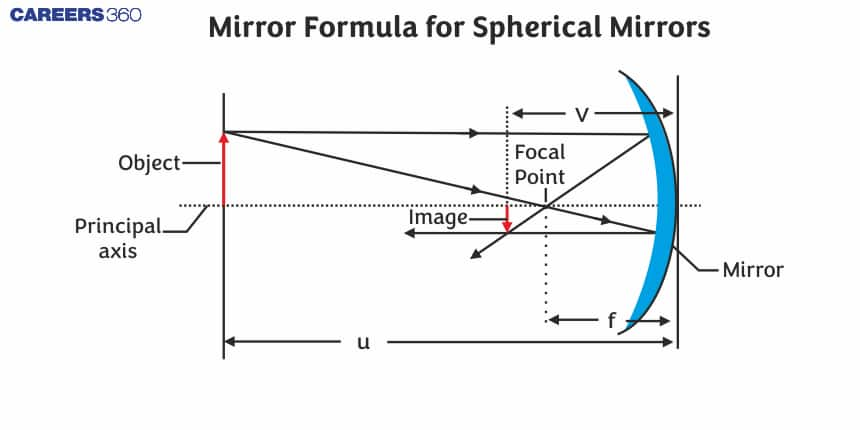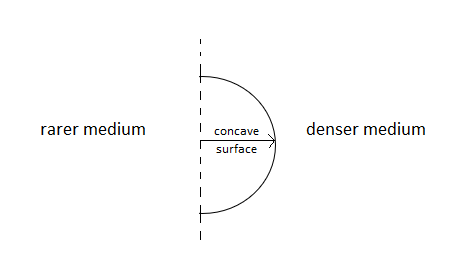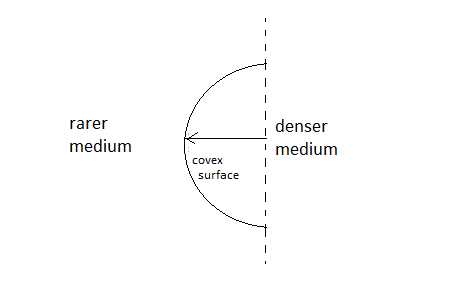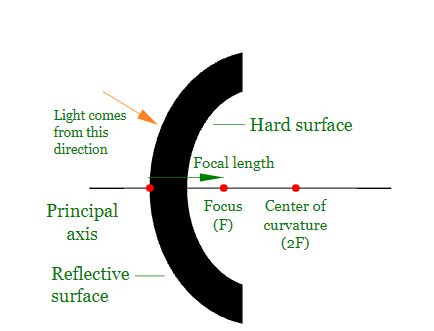Mirror Formula for Spherical Mirrors - Detailed Guide
In this article we are going to learn about the formula for spherical mirror ,sign convention for concave mirror, sign convention for convex mirror and also the sign convention for spherical lenses.
A spherical refracting surface is the part of a sphere separating two transparent media .There are two types of spherical refracting surfaces.
- Concave spherical refracting surface


- Convex spherical refracting surface

The spherical refracting surfaces have such components:

- Pole : The midpoint of a spherical refracting surface is called pole of the spherical surface.
- Centre of curvature : The centre of the sphere which forms a curved refracting surface , is known as centre of curvature.
- Radius of curvature : The radius of the sphere of which the refracting surface is a part is called the radius of curvature.
- Principal axis : The straight line joining the pole and the centre of curvature of the spherical refracting surface and the extended on both sides is called the principal axis of the surface.
- Aperture: The effective diameter of the refracting spherical surface exposed to the incident light is called the aperture.
Also read -
- NCERT Solutions for Class 11 Physics
- NCERT Solutions for Class 12 Physics
- NCERT Solutions for All Subjects
What is sign convention?
It is a selection of physical significance of signs for a particular quantity.
For sign convention we need to follow some assumptions/write the rules for sign convention:
The refraction through the spherical surface follows the following assumptions
- The object has to be a point object and it will lie on the principal axis.
- The aperture has to be small on the spherical refracting surface.
- Refraction of paraxial rays will be considered only.
Sign convention for mirror/sign convention for spherical mirror/ sign convention for reflection by spherical mirror:
- If the principal axis of the spherical reflecting surface is x-axis and distances along the y-axis above the principal axis, then the principal axis is taken as a positive sign and the y axis below the x-axis is taken as a negative sign.
- All distances are measured from the pole of the spherical surface.
- The distance measured from the pole in the direction opposite to the direction of the incident ray is taken as a negative sign and the measured direction of the incident ray is taken as a positive sign.
- The sign convention for a convex lens and concave mirror is the same.
- The sign convention for a concave lens and a convex mirror is the same.
- Relation between focal length (f) and radius of curvature (r) :
r=2f
- The general equation for lens / spherical mirror formula:
1/v+1/u=1/f
Where v is the image distance, u is the object distance f is the focal length of the lens.
This is also the formula for conjugate foci.
- Linear magnification formula :
m=-v/u
m is the linear magnification of the lens.
Linear magnification can also be the ratio of the height of the image to the height of the object.
m=I/O
=length or height of the image / length or height of the object
- Longitudinal or axial magnification:
mA=length of the image along the principal axis / length of the object along the principal axis
The spherical mirror longitudinal magnification is equal to the square of the linear magnification.
mA=m2
- The general form of refraction of light at the common spherical surface is when the light rays move from medium 1 to medium 2.

µ1 = refractive index of medium 1
µ2 = refractive index of medium 2
R = radius of curvature of a spherical surface.
Also Read:
- NCERT solutions for Class 12 Physics Chapter 9 Ray Optics and Optical Instruments
- NCERT Exemplar Class 12 Physics Solutions Chapter 9 Ray Optics and Optical Instruments
- NCERT notes Class 12 Physics Chapter 9 Ray Optics and Optical Instruments
- Newton’s equation:
xy=f2
Where, x = u – f ; y = v – f
- Lens maker’s formula :

Where = refractive index of the material of the lens with respect to the surrounding medium.
r1= radius of curvature of the medium 1 ;
r2 = radius of curvature of the medium 2.
- Power of a lens:
Power can be expressed as:
P=1/f
Here, f is focal length (meters) and D is the unit of power which is measured in dioptre.
Also check-
- NCERT Exemplar Class 11th Physics Solutions
- NCERT Exemplar Class 12th Physics Solutions
- NCERT Exemplar Solutions for All Subjects
NCERT Physics Notes:
Frequently Asked Questions (FAQs)
If the thickness of a lens is much less than the radius of curvature of two surfaces then that lens is known as a thin lens.
Focal length is the distance between the optical centre and the principal focus of a lens.
Focal length of a concave mirror is taken as the negative and the focal length of a convex mirror is taken as positive.
The pair of points is such that when an object is placed at one focal point on one side the image will be formed at the other focal point on the other side . These two focal points are called conjugate foci.
The point on the principal axis of the lens through which the rays of light emerge out without deviation after refraction is known as the optical centre of the lens.